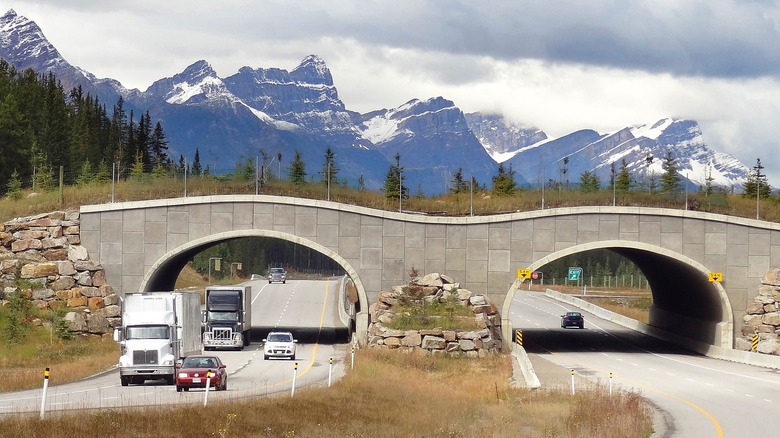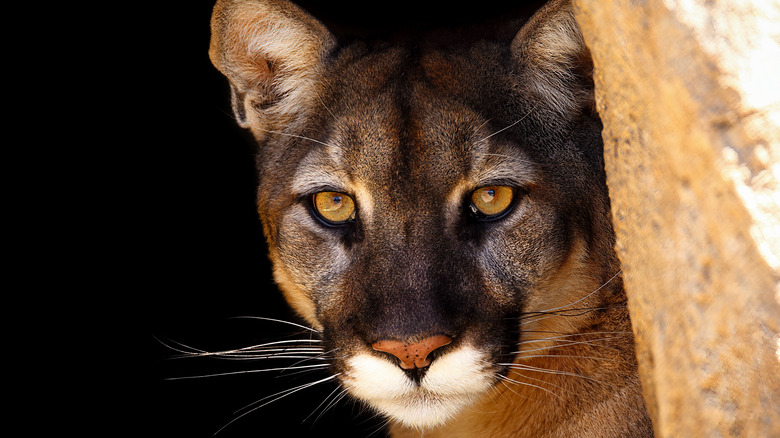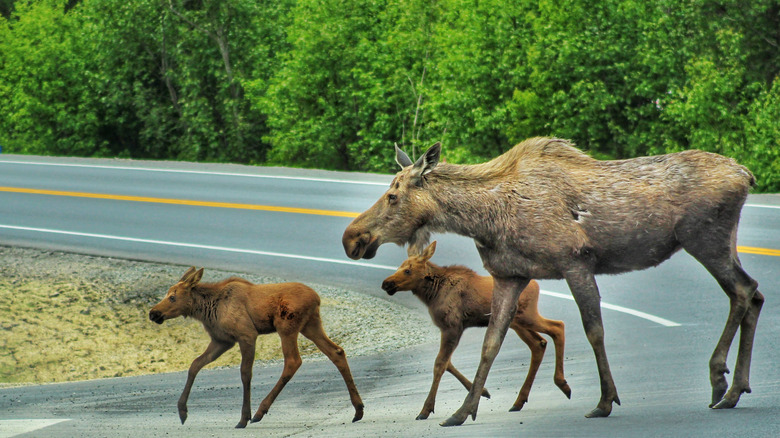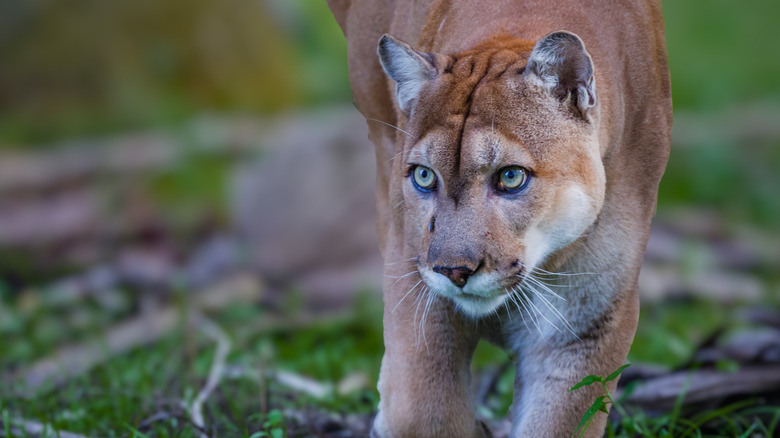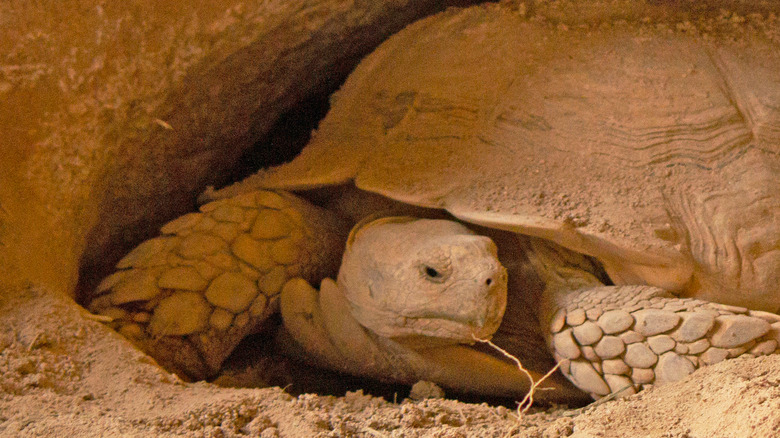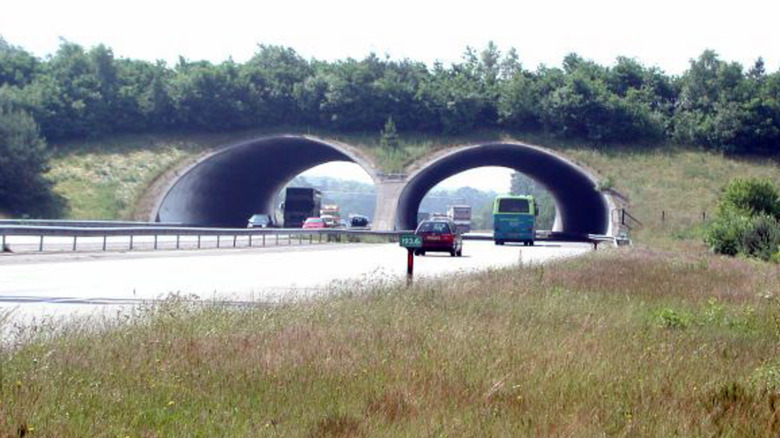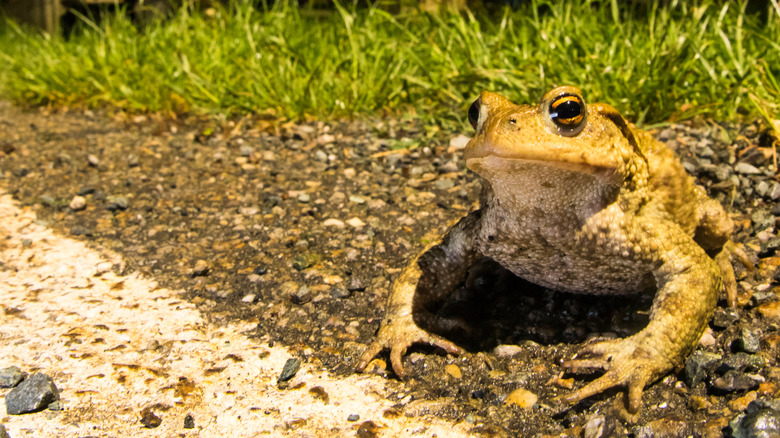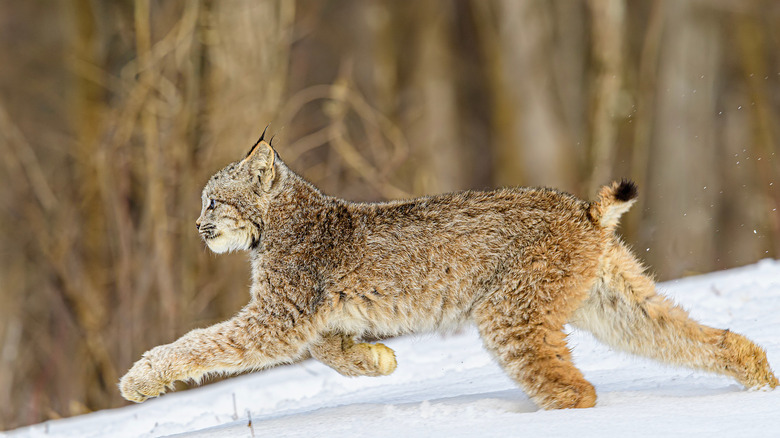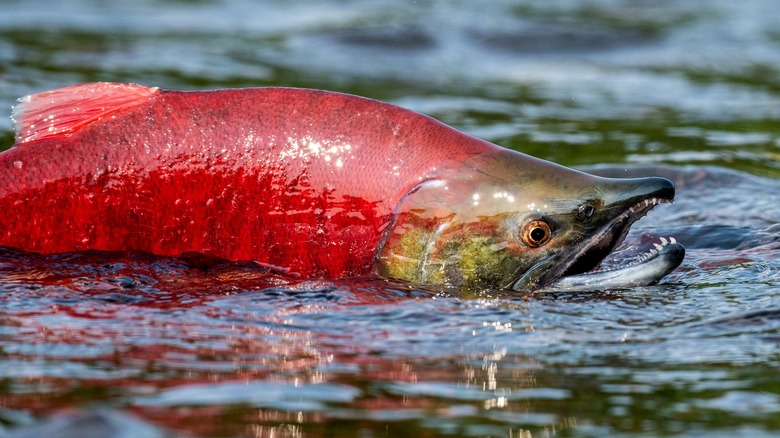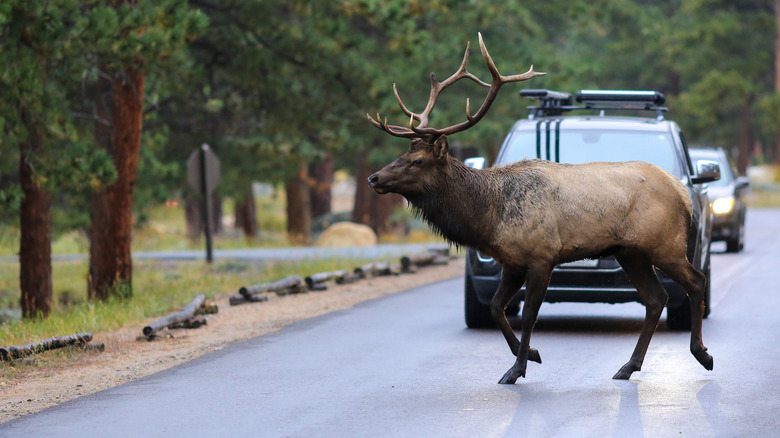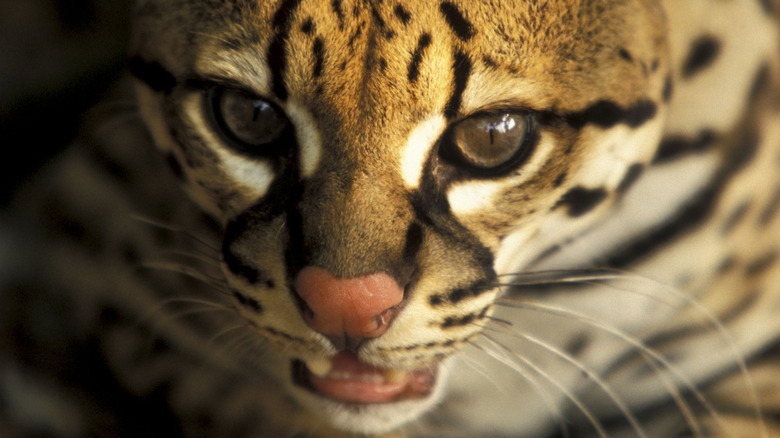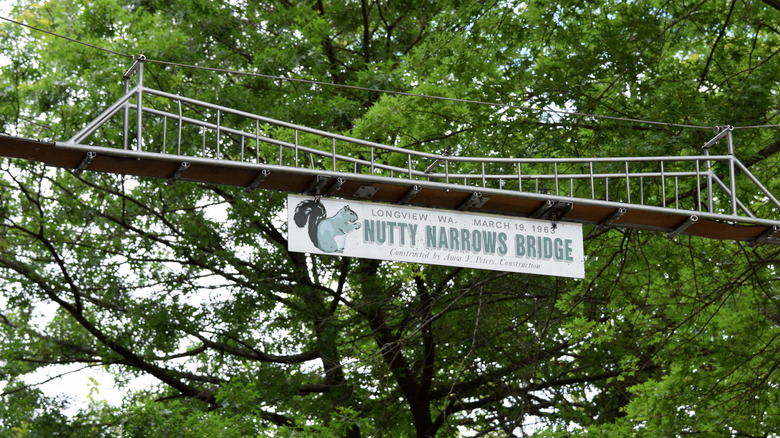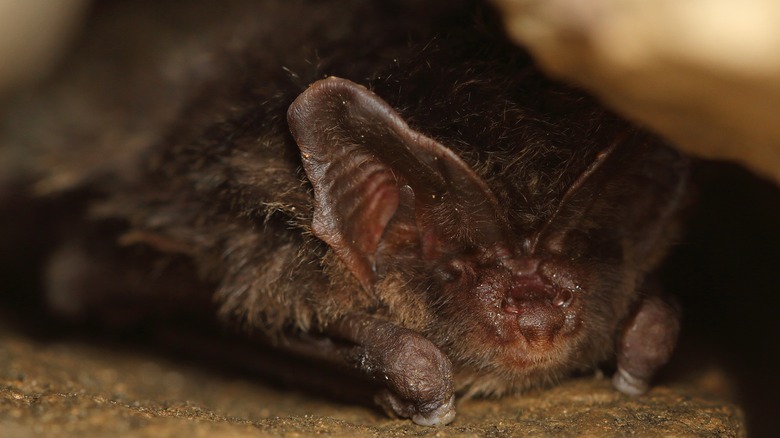12 Genius Animal Bridges And Crossings Around The World
You're driving along a twisty road through the woods after a long day at work, when suddenly something darts out onto the road in front of you. There's no time to swerve or hit the brakes. You barely have time to register the leaping deer before impact.
It's a story that happens every day in the United States. Insurance companies estimate that between 2020 and 2021, drivers struck more than 2 million animals. These accidents are believed to cost drivers and taxpayers more than $8 billion every year. These collisions don't only cost money, though. As noted by Psychology Today, studies have found that every year, approximately 29,000 people are injured and around 200 people are killed as a result of an animal-vehicle collision.
Deer aren't the only animals on the roads that drivers have to watch out for. Millions of squirrels, raccoons, possums, cats, and dogs are killed by cars every year. Smaller animals, like reptiles and birds, are rarely reported at all. As noted by CNBC, cars are one of the major threats to more than 20 endangered animals in the United States. There are many possible solutions to this deadly problem, but one of the most effective methods is also the most intuitive: keep animals off the roads in the first place. Wildlife crossings like animal bridges and underpass tunnels allow animals to travel safely without ever setting a paw on the road.
California's mountain lion crossing
In April of 2022, a vigil was held in an Agoura Hills suburb. It was honoring the more than a dozen mountain lions that died trying to cross nearby freeways. As stated by NPR, these animals died just outside LA. It might come as a surprise to find some of the most endangered animals in the United States living near one of the most populated cities, but the Santa Monica Mountains are their home. Since highway 101 cut through the mountains and the city has expanded around them, it has been almost impossible for the animals that live there to travel safely. Soon, a groundbreaking solution was proposed: a bridge to protect the big cats.
The Wallis Annenberg Wildlife Crossing is set to be completed in 2025, and at 210 feet long and 174 feet across it will be the largest ever built. The design includes light deflectors and noise suppressors to make the animals feel comfortable. As described by Audubon, the crossing will be planted with native plants like coastal sage scrub and chaparral, which will provide much-needed habitats to endangered birds and connect the animals to safe homes. As detailed in the New Yorker, the bridge is designed to help animals of all kinds that would otherwise be trapped by the freeways around the Santa Monica Mountains. The crossing will allow these animals to travel safely between the mountains, Simi Hills, and Los Padres National Forest without risking their lives on busy roads.
Trans-Canada Highway crossings
The Trans-Canada Highway cuts through the Rocky Mountains in Banff National Park. For the park's many visitors, the highway is the best way to see the park's scenery and wildlife. For the bears, wolves, deer, and wolverines that make those mountains their home, however, the road can be deadly.
As described by APEGA, starting in 1978, Public Works Canada began implementing multiple solutions to make the park safer for both wildlife and human visitors. The first strategy they implemented was "twinning" the road, cutting down on traffic. As detailed by Canadian Geographic, the next strategy was one of the most ambitious projects to preserve wildlife patterns ever created. They built six overpasses and 38 underpasses to allow animals to migrate safely across the highway. While many were skeptical when the project began (with the first two bridges being completed in 1996) incidents of cars striking wildlife in the park have reduced by 80%.
Many types of animals have been recorded using these crossings, including grizzly bears and moose.
Florida's 60 panther crossings
From 10-foot alligators to monkeys descended from theme park attractions, Florida is famous for its unusual animals. In recent years, Florida's panther population has been growing. As described by the National Wildlife Federation, this type of mountain lion has a distinctive crooked tail and can grow to be six or seven feet long. They are endangered, and only live at the Southwestern tip of Florida. As described by Florida's Fish and Wildlife Conservation Commission, more and more panthers were involved with collisions on the road. Multiple methods were used to protect the panthers, including lowering speed limits in areas they were likely to cross and adding reflectors to alert the animals to headlights earlier. While these methods helped, none were as effective as wildlife crossings.
In 1972, the very first wildlife crossings were installed in Florida. Today, there are 60. This includes underpasses and bridges for wildlife to use. Many use fencing to direct wildlife to the safe crossings and discourage them from crossing the highways. Often, they were installed in areas where radio tracking of panthers determined that the animals were already attempting to cross the road. As reported by NBC, not only are panthers using these crossings, but bobcats, deer, and bears have been spotted using them as well.
Southern California's tortoise culverts
The massive new Wallis Annenberg Wildlife Crossing isn't the only way for animals to get across major roads in California. On top of that, bridges aren't the only option. In Southern California, many wildlife habitats that would be divided by highways are reconnected by underpasses. As described by the Puente Hills Habitat Preservation Society, these tunnels underground are large enough to accommodate large animals like bobcats, coyotes, and deer. They aren't only for mammals, however.
Some underpasses (also known as culverts) were specifically designed to keep desert tortoises safe. These endangered tortoises are the largest reptile that can be found in the Southwestern United States. They can live anywhere from 50 to 100 years. Keeping these tortoises, which are naturally slow moving, off the roads can be challenging. Fortunately culverts have been designed specifically for them to use. Like many other wildlife crossings, they use fencing to direct animals to the safe passage across — or rather underneath — the road. This is more challenging when designing for a tortoise, however, as they are excellent diggers. Ultimately, mesh fencing both above and below ground have been used to direct the tortoises into culverts. This not only keeps these rare reptiles safe from cars and trucks, but allows them to travel to new habitats and find new mates.
Tunnels and ecoducts in the Netherlands
In Europe, wildlife overcrossings like wildlife bridges are often called "ecoducts." According to Smithsonian Magazine, the Netherlands is home to more than 600 crossings intended to keep its wildlife safe from being hit by cars on busy roads. The Netherlands boasts the largest ecoduct, which stretches more than half a mile across a major highway, train tracks, a river, a sports complex, and a golf course. As stated by Atlas Obscura, this massive wildlife bridge — called Natuurbrug Zanderij Crailoo — is located in Hilversum. The planted bridge connects wooded habitats, allowing local deer, wild boar, and the endangered European badger to make the journey safely.
Not all of the Netherlands' wildlife crossings are as big as Natuurbrug Zanderij Crailoo, however. In a collaboration between conservationists and gas companies, other underground pipes have been installed under roads to allow small animals like foxes and mice to run underneath (via Pacific Standard).
Toad tunnels for spring safety
On rainy spring nights in the forest, frogs and salamanders erupt out of the soil, having hibernated underground all winter. As soon as they're out, they rush to find woodland pools where they can mate and lay their eggs. Unfortunately, when there are roads between their hibernation places and the water, thousands of amphibians are killed. In New York state, the DEC recruits hundreds of volunteers to physically scoop up and carry thousands of frogs across the road. But according to recent research, there may be a way for amphibians to get across roads safely themselves.
The majority of studies on "toad tunnels" or culverts found that amphibians used the underpasses and reduced deaths on the road. Fences and barriers have often been used to direct frogs to the entrances of the tunnels. Some of these have been specifically designed to include flowing water to encourage use by frogs (though results were mixed, with some studies indicating that dry tunnels were just as useful.)
Colorado's Vail Pass contest
All roads are hazards for wildlife, but Colorado's Interstate 70 has always been particularly deadly. As noted by Summit Daily, it is incredibly difficult for animals to cross, earning it the nickname "Berlin Wall."
There were regular collisions and several injuries to humans around Vail Pass for years. As noted by CBS, I-70 currently only has two lanes in that region, so every time there was a serious accident, the road had to close. Animals killed there have included coyotes, deer, elk, and lynx. The reason so many animals find themselves on the highway is because I-70 goes through the Rockies, cutting that ecosystem in half. The natural solution was to give the animals another way through — but finding the right way to do it wasn't as obvious.
A competition was held to find the best possible design for a wildlife crossing. Designs from top design firms around the world were submitted. The chosen plan includes six different crossings for animals, all underpasses. The project is currently underway.
Fish passages for aquatic life
HIghways aren't only an issue for land animals. As explained by NOAA, new roads can disrupt fish migration and cut them off from their habitats. Fortunately, there are engineering solutions to help these aquatic animals find their way to the sea.
In Washington State, state highways like I-90 have become impassable barriers, cutting fish off from their natural habitats. In an area known as Sunset Creek, this has become a particular issue for salmon. Salmon migrate throughout their life, returning to the same place they were born to spawn. As detailed by USGS, they will sometimes travel for hundreds of miles to the ocean (and possibly another thousand miles looking for food once they reach the sea). Soon, however, the Washington State Department of Transportation will construct hundreds of passages for fish to safely swim beneath the roads. These will reopen areas of their habitats that they have been cut off from for years.
Originally, large pipes under the roads were designed to be as small as possible while still allowing water through, but this doesn't necessarily work for fish. As described by Snohomish County Washington's Fish Passage Culvert Program, the water often enters these pipes via a steep drop and can flow too quickly for fish to use. Soon, these will be redesigned with more gentle slopes, more natural light, and a natural substrate like sand or river rocks at the bottom to help the fish feel comfortable using them.
Wyoming's elk jumps
Sometimes the way to prevent animal collisions on the road is simply to allow animals to get off the road themselves. In Wyoming's National Elk Refuge, elk, bison, and wolves live free in their natural habitat. However, the refuge is bordered on one side by Highway 89. A large fence keeps animals in the refuge from wandering out onto the road, but unfortunately it can also keep animals on the highway out of the refuge.
As stated by Buckrail, elk migrate through different territories with the seasons. At the height of migration, elk sometimes attempt to cross or even travel on the highway. In 2017, new features called "elk jumps" were added to the boundary fence. These are simply breaks in the fence that allow elk on the road to leap to the safety of the refuge. These openings in the barrier are specifically designed to be raised, meaning that it is easy for the elk to leap down into the refuge, but very difficult to jump back up onto the road. This encourages them to migrate from the unfenced part of the refuge, which doesn't lead them across the highway.
Texas' ocelot underpasses
There is one place in the United States where there are still wild ocelots — but not very many. Experts estimate that there are around 80 ocelots still living in South Texas. As noted by Valley Central local news, the most common cause of death for these endangered animals is being struck by cars while trying to cross the road. In 2019, the Texas Department of Transportation and the United States Fish and Wildlife Service created 12 new underpasses in Rio Grande Valley to keep the ocelots safe. Ocelots have since been seen using the underpasses, marking the first time their species has used a wildlife crossing
As noted by the U.S. Fish and Wildlife Service, this was due to the roads in and around the Laguna Atascosa National Wildlife Refuge. Many of these are now outfitted with underpasses, allowing ocelots to travel safely within the refuge. Scientists monitoring the underpasses have also reported that other animals have used the passages safely rather than going on the road, including alligators, armadillos, and bobcats.
Squirrel bridges in Longview, Washington
Not all crossings are for endangered animals. In Longview, Washington, a unique crossing for a common backyard animal has become a local tourist attraction.
In 1963, a builder named Amos Peters was working around an office building near a busy road. People who worked in the building came to love their neighborhood squirrel population, and would often leave out nuts for them. Unfortunately, in order to reach their office, the squirrels had to make a dangerous crossing. More than once, Peters and office staff saw their beloved squirrels struck and killed by passing cars. Soon, the squirrel lovers had petitioned their city council to allow for a new way for the squirrels to cross: a squirrel bridge.
The bridge, later named "Nutty Narrows," is 60 feet long. Although it has been repaired and refurbished over the years, "Nutty Narrows" still allows squirrels to cross the road safely. Since then, the city has added many more squirrel bridges to keep the animals safe as they cross the city's roads.
The U.K.'s controversial bat bridges
In the U.K., seven tall structures resembling telephone poles with mesh hung from the wires were erected across the roads. As reported by the BBC, this was in response to studies that found that more than 40% of bats were crossing the roads at heights low enough that they were in danger of being hit by oncoming traffic. Some of these bats, like the barbastelle bat, are highly endangered, and need to be protected.
The initial concept was simple: in nature, bats fly along the tree line. In theory, bats should instinctively follow the poles and the net instead of flying low enough to be hit by cars. Unfortunately, since they have been introduced, there has been little evidence of bats crossing at the bridges — though it's too soon to say for certain if they will work or not.
A different type of bridge has become a lifesaver for bats. As described by Bat Conservation International, one of the major risks to bats is a lack of safe places to roost. In the United States, most bats evolved to sleep in crevices in massive trees or empty caves — many of which are now gone. Instead, many turn to highway structures like bridges and culverts. In some places, over a million bats make their homes on the underside of a single bridge. Conservationists hope to modify existing bridges and underpasses designed for cars to include bat boxes and panels that will help them to roost.
